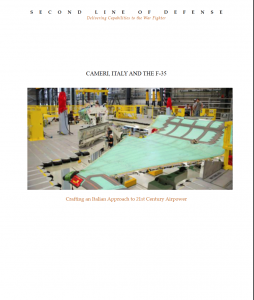2013-12-03 We have just published a Special Report drawing together a number of key interviews and analyses of the Italian approach to the F-35.
In the report, we look at the Italian engagement with the F-35 and the thinking of Italian airpower leaders about the impact of the F-35 on the future.
At Cameri, Italians are standing up a Final Assembly and Check Out Facility or FACO, a Final Wing Assembly for building for the global fleet, and Fleet Sustainment Facility for the region, including Europe, the Mediterranean and the Middle East.
The Cameri facility includes both an ATF or Aircraft Test Facility (for testing stealth performance) and a final paint facility. This means that in the heart of Europe, the F-35 fleet will have a battle damage facility.

Cameri, Fort Worth, Japan and Israel will all see key elements of the F-35 global production system. This means that for the first time, the United States in building its front line fighter is looking to work differently with allies. In turn, allies are building out a global sustainment capability available to those nations, which buy, into the F-35 fleet.
Significant cross learning has already occurred, but is just beginning. The advantages of building a global system where best practices can be developed are obvious.
Building a global sustainment approach is less so. But the impact on the cost of operations of an airfleet is significant.
Rather than bringing the logistical support equipment and material to the operational forward base, the forward deployment of warehoused parts and regionally based sustainment competencies will not only allow and air fleet to move rapidly to a problem but to reduce the need for surge airlift and tanking to get those supplies to the point of attack.
This is part of what the head of the Italian Air Force refers to the F-35 as part of building new coalition capabilities and shaping an F-35 fleet which can operate through coalitions against distributed challenges with distributed operational capabilities.
We start the Special Report by providing the interviews with RADM Covella, the head of the F-35 program in Italy, Lt. General Preziosa, the head of the Italian Air Force, BG Espisoto and Lt General Lupoli who focused on their perspectives on the F-35 and the evolution of Italian airpower.
We next add a look at the impact of the new aircraft on the latest Italian aircraft carrier, the Cavour. What is the impact of shifting from Harriers to F-35Bs on the role of this type of ship?
We next examine the perspectives of four key industrial executives working in Italy with Alenia Aermacchi (AAeM) to make Cameri a reality. Their experience and perspectives are unique and are part of a new approach to Euro-American defense industrial cooperation.
We then close with two more general pieces providing overviews.
The first looks at the nature of change posed by the Italian experience for the Asians as the Japanese add their own FACO facility.
The second looks at the general approach of the F-35 program to allies and the role of global investments.
It is the case of a 21st century combat aircraft built in global 21st century facilities with a global sustainment approach built in.
This is a unique moment in military aviation history.
https://www.sldinfo.com/cameri-italy-and-the-f-35-special-report/
Or can be read as a flipbook:
https://sldinfo.com/flipbooks/Italy/ItalianF-35SpecialReport1/


